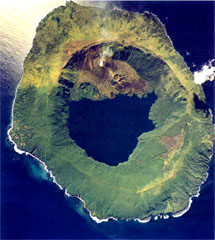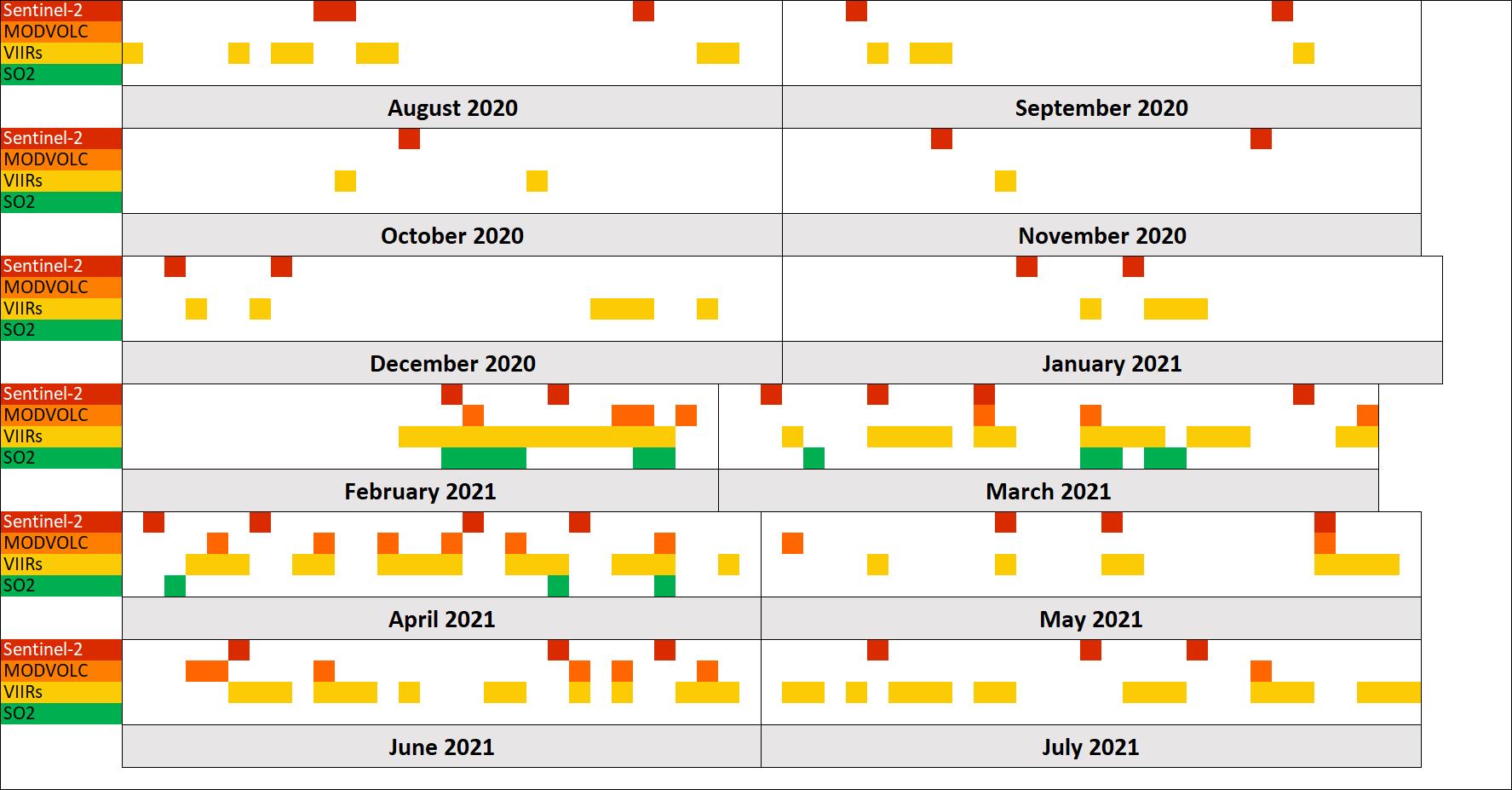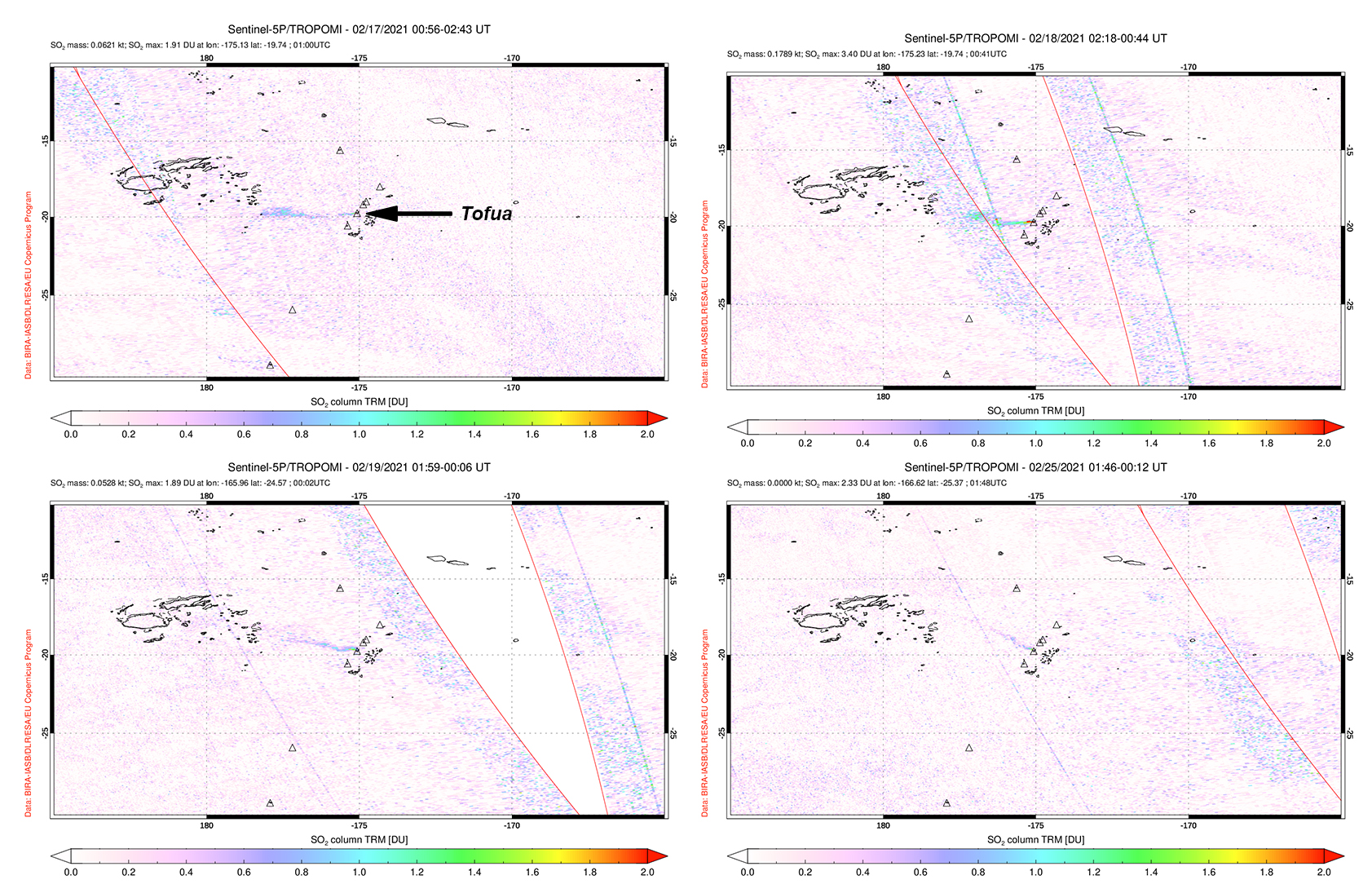Report on Tofua (Tonga) — August 2021
Bulletin of the Global Volcanism Network, vol. 46, no. 8 (August 2021)
Managing Editor: Edward Venzke.
Edited by Kadie L. Bennis.
Tofua (Tonga) Intermittent thermal anomalies and sulfur dioxide emissions in the Lofia crater during August 2020-July 2021
Please cite this report as:
Global Volcanism Program, 2021. Report on Tofua (Tonga) (Bennis, K.L., and Venzke, E., eds.). Bulletin of the Global Volcanism Network, 46:8. Smithsonian Institution. https://doi.org/10.5479/si.GVP.BGVN202108-243060
Tofua
Tonga
19.75°S, 175.07°W; summit elev. 515 m
All times are local (unless otherwise noted)
Tofua is a remote volcano in the central part of the Tonga Islands group that contains a 5-km-wide caldera; three post-caldera cones were constructed at the N end of a caldera lake. The easternmost cone has three craters that have produced young basaltic-andesite lava flows, some of which traveled into the caldera lake. The largest and northernmost of the cones, Lofia, has a steep-sided crater that is 70 m wide and 120 m deep and has been the source of historical eruptions dating back to the 18th century. Recent activity has been characterized by intermittent thermal anomalies in the Lofia crater (BGVN 45:08), which continues through this reporting period of August 2020 through July 2021. Information primarily comes from satellite data.
Summary of activity during August 2020-July 2021. No ash advisories were issued during the reporting period; however, intermittent hotspots were detected by Sentinel-2 thermal satellite imagery and Suomi NPP/VIIRS sensor data throughout the reporting period (figure 12). Anomalies from the MODVOLC system clustered during February 2021 through April and June. There was a notable increase in activity during mid-February through July, compared to the previous months, which included distinct sulfur dioxide plumes (figure 13) and consecutive days with thermal anomalies, according to NASA VIIRs satellite data.
Sentinel-2 infrared satellite imagery and NASA Worldview detected intermittent thermal anomalies during August 2020 through July 2021 dominantly in the Lofia crater (figure 14); rare fires were noted along the NW coast of the island. Beginning in mid-February, the activity notably increased with a stronger thermal anomaly. This increase was accompanied by white gas-and-steam emissions, which included distinct sulfur dioxide plumes.
Geological Summary. The low, forested Tofua Island in the central part of the Tonga Islands group is the emergent summit of a large stratovolcano that was seen in eruption by Captain Cook in 1774. The summit contains a 5-km-wide caldera whose walls drop steeply about 500 m. Three post-caldera cones were constructed at the northern end of a cold fresh-water caldera lake, whose surface lies only 30 m above sea level. The easternmost cone has three craters and produced young basaltic-andesite lava flows, some of which traveled into the caldera lake. The largest and northernmost of the cones, Lofia, has a steep-sided crater that is 70 m wide and 120 m deep and has been the source of historical eruptions, first reported in the 18th century. The fumarolically active crater of Lofia has a flat floor formed by a ponded lava flow.
Information Contacts: MIROVA (Middle InfraRed Observation of Volcanic Activity), a collaborative project between the Universities of Turin and Florence (Italy) supported by the Centre for Volcanic Risk of the Italian Civil Protection Department (URL: http://www.mirovaweb.it/); Hawai'i Institute of Geophysics and Planetology (HIGP) - MODVOLC Thermal Alerts System, School of Ocean and Earth Science and Technology (SOEST), Univ. of Hawai'i, 2525 Correa Road, Honolulu, HI 96822, USA (URL: http://modis.higp.hawaii.edu/); NASA Global Sulfur Dioxide Monitoring Page, Atmospheric Chemistry and Dynamics Laboratory, NASA Goddard Space Flight Center (NASA/GSFC), 8800 Greenbelt Road, Goddard, Maryland, USA (URL: https://so2.gsfc.nasa.gov/); NASA Worldview (URL: https://worldview.earthdata.nasa.gov/); Sentinel Hub Playground (URL: https://www.sentinel-hub.com/explore/sentinel-playground).




